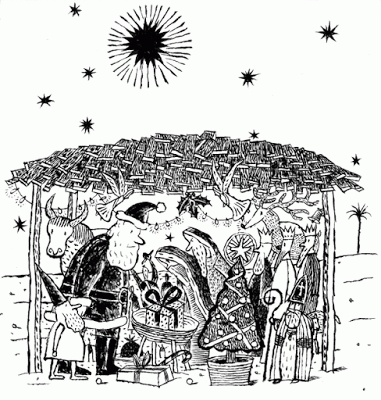‘Narnia is a mongrel thing, and so is Christmas. As is often the case, this mongrelizing is the source of its strength.’
By Laura Miller / December 18, 2008
Every Christmas, I re-read C .S. Lewis’s novel “The Lion, the Witch and the Wardrobe.” The holiday seems like the ideal time for an excursion into my imaginative past, and so I return to the paperback boxed set of “The Chronicles of Narnia” that my parents gave me for Christmas when I was 10. For me, Narnia is intimately linked with the season.
I’m not alone. In Britain, stage productions of “The Lion, the Witch and the Wardrobe” are a holiday staple, for good reason. The book rests on a foundation of Christian imagery; its most famous scene is of a little girl standing under a lamppost in a snowy wood; and Father Christmas himself makes an appearance, after the lion god Aslan frees Narnia from an evil witch who decreed that it be “always winter, and never Christmas.”
That I’m not a Christian doesn’t much hinder my enjoyment of either the holiday or the book, but the presence of Father Christmas bothered many of Lewis’s friends, including J.R.R. Tolkien. Tolkien, whose Middle-earth was free of the legends and religions of our world, objected to Narnia’s hodgepodge of motifs: the fauns and dryads lifted from classic mythology, the Germanic dwarfs and contemporary schoolboy slang lumped in with the obvious Christian symbolism.
But Lewis embraced the Middle Ages’ indiscriminate mixing of stories and motifs from seemingly incompatible sources. The medievals, he once wrote, enthusiastically adopted a habit from late antiquity of “gathering together and harmonizing views of very different origin: building a syncretistic model not only out of Platonic, Aristotelian and Stoical, but out of pagan and Christian elements.”
Christmas as we now know it is much the same sort of conglomeration, and when people call for a return to its pure, authentic roots, they’re missing an essential quality of the holiday. Narnia is a mongrel thing, and so is Christmas. As is often the case, this mongrelizing is the source of its strength.
Complaints about the corruption, dilution or fundamental impiety of Christmas have been made for centuries. The Puritans so mistrusted the holiday that its celebration was outlawed in 17th-century Boston. Around the same time, the German theologian Paul Ernst Jablonski asserted that Christmas amounted to a paganization of the authentic faith because the date, Dec. 25, had been appropriated from a festival for a Roman solar god.
(Some Christian scholars, including the current pope, have actually argued that the appropriation went the other way around, and the solar festival was in fact a heathen bid to co-opt the feast day of an increasingly popular monotheistic cult.)
On the other side, non-Christians who relish the holiday like to point out that many Christmas icons — the decorated tree, the Yule log, mistletoe — were originally sacred to Celtic and Northern European pagans.
Yet even the Yuletide customs that are supposedly pagan holdovers must be taken with a grain of salt. We have no written records of the cultures from which they supposedly derive; everything we know about them comes second- and thirdhand from Roman or Christian writers pursuing their own agendas and relying, for the most part, on oral sources.
For decades, historians and folklorists have understood that oral traditions are not very reliable when they refer to anything reputed to have happened more than 100 years ago. What’s presented as hoary legend is in fact more likely a justification of present conditions than an accurate account of the past.
Druids, for example, have over the years been refashioned as the descendants of Noah, as bardic romantics, even as sexual egalitarians; in fact, much of what people think they know about the ancient beliefs and rites of Northern Europeans was concocted by early 20th-century occultist outfits like the Ancient Druid Order and Hermetic Order of the Golden Dawn.
The British historian Ronald Hutton describes this sort of thing as indicative of “the power of literary fiction over fact.” We believe what we choose to believe, and Christmas is no exception.
In recent years, popular histories like “The Battle for Christmas” and “Inventing Christmas,” have shown that many of the holiday’s most hallowed rites, traditions we think of as extending back at least as far as C. S. Lewis’s beloved Middle Ages, were invented less than 200 years ago by such 19th-century literary figures as Washington Irving, Clement Clarke Moore and, of course, Charles Dickens. More than Christian or pagan, Christmas is a Victorian fabrication.
Is this, though, such a bad thing? The unifying principle of Narnia, unlike the vast complex of invented history behind Middle-earth, isn’t an illusion of authenticity or purity. Rather, what binds all the elements of Lewis’s fantasy together is something more like love. Narnia consists of every story, legend, myth or image — pagan or Christian — that moved the author over the course of his life.
Our contemporary, semi-secular Christmas is similarly a collection of everything yearned for: warmth, plenty, peace, family, conviviality. Like Narnia, the holiday is a fantasy, but there are times when a fantasy is exactly what you need.
[Laura Miller, a staff writer at Salon, is the author of “The Magician’s Book: A Skeptic’s Adventures in Narnia.”]
Source / New York Times
Thanks to Jim Retherford / The Rag Blog



















"Warmth, peace, plenty & conviviality" may not be everything for which we yearn, but it's not a bad start. While Christmas is unquestionably a commercial circus in this country, 'objectors' run the risk of throwing the baby (honestly, no pun intended) out with the bathwater. Joseph Campbell ably demonstrated the universality & value of seasonal rituals, however